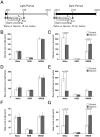Orexin neurons receive glycinergic innervations
- PMID: 21949857
- PMCID: PMC3174993
- DOI: 10.1371/journal.pone.0025076
Orexin neurons receive glycinergic innervations
Abstract
Glycine, a nonessential amino-acid that acts as an inhibitory neurotransmitter in the central nervous system, is currently used as a dietary supplement to improve the quality of sleep, but its mechanism of action is poorly understood. We confirmed the effects of glycine on sleep/wakefulness behavior in mice when administered peripherally. Glycine administration increased non-rapid eye movement (NREM) sleep time and decreased the amount and mean episode duration of wakefulness when administered in the dark period. Since peripheral administration of glycine induced fragmentation of sleep/wakefulness states, which is a characteristic of orexin deficiency, we examined the effects of glycine on orexin neurons. The number of Fos-positive orexin neurons markedly decreased after intraperitoneal administration of glycine to mice. To examine whether glycine acts directly on orexin neurons, we examined the effects of glycine on orexin neurons by patch-clamp electrophysiology. Glycine directly induced hyperpolarization and cessation of firing of orexin neurons. These responses were inhibited by a specific glycine receptor antagonist, strychnine. Triple-labeling immunofluorescent analysis showed close apposition of glycine transporter 2 (GlyT2)-immunoreactive glycinergic fibers onto orexin-immunoreactive neurons. Immunoelectron microscopic analysis revealed that GlyT2-immunoreactive terminals made symmetrical synaptic contacts with somata and dendrites of orexin neurons. Double-labeling immunoelectron microscopy demonstrated that glycine receptor alpha subunits were localized in the postsynaptic membrane of symmetrical inhibitory synapses on orexin neurons. Considering the importance of glycinergic regulation during REM sleep, our observations suggest that glycine injection might affect the activity of orexin neurons, and that glycinergic inhibition of orexin neurons might play a role in physiological sleep regulation.
Conflict of interest statement
Figures







References
-
- Curtis DR, Hösli L, Johnston GA. A pharmacological study of the depression of spinal neurones by glycine and related amino acids. Exp Brain Res. 1968;6:1–18. - PubMed
-
- Probst A CR, Palacios JM. The distribution of glycine receptors in the human brain. A light microscopic autoradiographic study using [3H]strychnine. Neuroscience. 1986;17:11–35. - PubMed
-
- Araki T YM, Murakami T, Wanaka A, Betz H, Tohyama M. Localization of glycine receptors in the rat central nervous system: an immunocytochemical analysis using monoclonal antibody.. Neuroscience. 1988;25:613–624. - PubMed
-
- Johnson JW, Ascher P. Glycine potentiates the NMDA response in cultured mouse brain neurons. Nature. 1987;325:529–531. - PubMed
-
- Kleckner NW, Dingledine R. Requirement for glycine in activation of NMDA-receptors expressed in Xenopus oocytes. Science. 1988;241:835–837. - PubMed
Publication types
MeSH terms
Substances
LinkOut - more resources
Full Text Sources
Other Literature Sources

